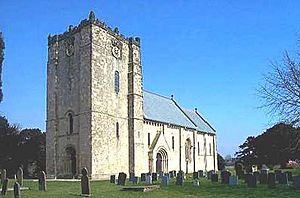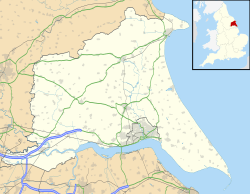Church of St Michael and All Angels, Garton on the Wolds facts for kids
Quick facts for kids Church of St Michael and All Angels |
|
|---|---|
| Church of St Michael and All Angels, Garton on the Wolds | |

"Quite exceptional Victorian decoration" – restored in memory of Sir Nickolaus Pevsner
|
|
| 54°01′14″N 0°30′10″W / 54.0206°N 0.5027°W | |
| OS grid reference | SE 98197 59328 |
| Location | Garton on the Wolds, East Riding of Yorkshire |
| Country | England |
| Denomination | Church of England |
| History | |
| Founded | 1132 |
| Dedication | Saint Michael |
| Architecture | |
| Heritage designation | Grade I |
| Designated | 20 September 1966 |
| Administration | |
| Diocese | Diocese of York |
The Church of St Michael and All Angels is a very old and beautiful church located in Garton on the Wolds, a village in the East Riding of Yorkshire, England. It was first built around 1132 for the monks of Kirkham Abbey. Over the years, especially in the 1800s, it was greatly changed and decorated by the wealthy Sykes family of Sledmere.
Sir Tatton Sykes, 4th Baronet hired a famous architect named John Loughborough Pearson to rebuild much of the church between 1856 and 1857. Later, his son, the fifth baronet, asked another architect, George Edmund Street, to design special paintings for the inside walls. These paintings show many stories from the Bible.
When a famous historian named Nikolaus Pevsner wrote about the church in 1972, he noted that the murals were "dirty and decaying." After he passed away, a group called the Pevsner Memorial Trust helped restore these amazing paintings between 1985 and 1991. The church is still used for services today and is considered a very important historic building, known as a Grade I listed building.
Contents
History of the Church
Historic England says the church was built around 1132. It was made for the leader of Kirkham Abbey. Another historian, David Neave, explains that the land was given to the abbey in 1121. The church was then rebuilt soon after.
Changes Over Time
More work was done on the church in the 1300s and 1400s. This included building the top part of the church tower. By the 1800s, the church was falling apart. So, Sir Tatton Sykes the Fourth hired J. L. Pearson to completely restore it from 1855 to 1857. Most of the church you see today was built by Pearson, except for the tower and a few other parts.
Sir Tatton Sykes the Fifth later decided to hire G. E. Street in 1865 to decorate the inside. Sir Sykes spent a huge amount of money, about £150,000, on building and restoring churches on his land in Yorkshire. David Neave mentioned that even with all this money spent, many people in Garton still chose to be Methodist instead of joining the Church of England.
The Famous Wall Paintings
The beautiful wall paintings inside the church were made in 1865. They were created by a well-known company called Clayton and Bell. These paintings cover almost all the inside walls of the church. They show many different scenes from the Bible. The total cost for these decorations was about £3,000.
The mid-1800s was a time of big changes for churches. In 1859, Charles Darwin published his book On the Origin of Species. This book presented new ideas about how life developed. Some people believe that the murals were Sir Sykes's way of showing his strong belief in the traditional teachings of the church.
Saving the Murals
When Nikolaus Pevsner wrote about the church in 1972, he saw that the murals were in a "pitiful" state. He said it was "essential that they be preserved." By the time Pevsner passed away about ten years later, the murals were badly damaged by dampness and dirt.
Friends and colleagues of Pevsner decided to raise money to restore the murals in his memory. An architectural historian named John Newman led the fundraising group, the Pevsner Memorial Trust. They chose the murals at St Michael and All Angels as a good project. They worked hard to raise the £100,000 needed. David Neave's updated guide from 2005 notes that the murals were successfully restored and saved between 1986 and 1991.
The church is still an active church today and holds regular services for its community.
Church Design and Features
The Church of St Michael and All Angels is built from sandstone blocks. The bottom two levels of the three-story tower are from the original church built in the 1100s. The top level was added later, in the 1400s, in a style called Perpendicular Gothic. The main entrance, or doorway, looks like an Early Gothic style, but it was part of Pearson's rebuilding work. The church also has some important examples of old Romanesque carvings.
Inside the Church
The paintings in the main part of the church, called the nave, show scenes from the Old Testament. The paintings in the chancel, near the altar, show scenes from the New Testament. These murals are considered some of the best work done by Clayton and Bell. They also made the beautiful stained glass windows and painted the church roofs.
The special floor tiles in the chancel and nave, called Cosmati paving, were added later in 1878 when Pearson worked on the church again. Pearson had seen similar beautiful tile work from the 1100s during his travels in Italy. Neave mentioned that this flooring "has not worn well." Underneath the murals, there is a lower wall decoration, or dado, made of "Spanish" style tiles. These tiles were made by Frederick Garrard of Millwall and cost £166.
The church is officially recognized as a Grade I listed building, meaning it is a very important historic site.



